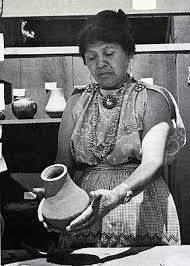Crucita Calabaza facts for kids
Quick facts for kids
Crucita Gonzales Calabaza
|
|
|---|---|
| (Blue Corn) | |

Crucita Calabaza (Blue Corn)
|
|
| Born |
Crucita Gonzales
December 7, 1921 |
| Died | May 3, 1999 (aged 77) |
| Nationality | San Ildefonso Pueblo, American |
| Occupation | Native American Potter and Artist |
| Known for | Polychrome San Ildefonso Pueblo Pottery |
| Spouse(s) | Santiago "Sandy" Calabazas |
| Children | 10 |
| Relatives | 18 grandchildren, 12 great-grandchildren |
Crucita Gonzales Calabaza (born December 27, 1921 – died May 3, 1999) was a famous Native American artist. She was also known as Blue Corn. She was a talented potter from the San Ildefonso Pueblo in New Mexico, United States. Blue Corn became well-known for bringing back a special style of pottery. This style used many colors, called polychrome wares, at San Ildefonso. She had a very long and successful career.
Early Life of Blue Corn
Crucita Gonzales was born on December 27, 1921. Her birthplace was the San Ildefonso Pueblo in Santa Fe County, New Mexico. Her family name, Gonzales, is sometimes spelled Gonzalez. Her grandmother first taught her how to make pottery. Crucita was only three years old at the time.
During a special naming ceremony, she received the name Blue Corn. This name was given to her by the sister of a famous potter, Maria Martinez. Blue Corn learned how to make a unique type of pottery. It was called Black-on-black ware, and she learned this from Maria Martinez.
Blue Corn went to school at her pueblo when she was young. Later, she attended the Santa Fe Indian School. This school was about 24 miles (39 km) away from her home. While she was studying in Santa Fe, her parents passed away. She then moved to live with relatives in southern California. For a short time, she worked as a maid in Beverly Hills.
When she was 20, she married Santiago "Sandy" Calabaza. He was a silversmith from Kewa Pueblo. They settled down at San Ildefonso. There, they had and raised 10 children. During World War II, Blue Corn worked as a housecleaner. She worked for the physicist, J. Robert Oppenheimer, in Los Alamos.
Blue Corn's Pottery Career
After her first son, Joseph, was born, Blue Corn returned to making pottery. Her husband, Santiago, quit his job to help her. He helped her carve, paint, and design her beautiful pots. By the late 1960s, she was known as a leader in polychrome styles.
After her husband passed away in 1972, her son Joseph started helping her. He continued to assist her with her pottery. In the 1960s and 1970s, Blue Corn taught many workshops. She showed people how to make pottery in both the U.S. and Canada.
Blue Corn also made redware and blackware pottery. However, she is most famous for her finely polished surfaces. She also experimented a lot with different clays and colors. This allowed her to create cream polychrome designs on jars and plates. Her feather and cloud designs are especially well-known.
Blue Corn is famous for bringing back fine whiteware pottery. This pottery used many colors. She received great praise from many places, including The Wall Street Journal. Her pottery can be seen in the Smithsonian Institution. It is also in other major museums across America and Europe. Many private collectors own her work too. She won more than 60 awards for her art. In 1981, she received the 8th Annual New Mexico Governors Award. This is the highest award for art in New Mexico.
Later Life and Legacy
Crucita Calabaza passed away on May 3, 1999. She left behind her ten children. She also had 18 grandchildren and 12 great-grandchildren. Her artistic legacy continues to inspire many.

